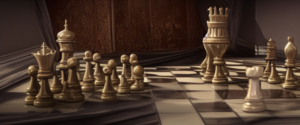I like analyzing chess games, as I believe that it is a critical step in improving one’s chess skills. Beginners should focus on understanding the basic principles of chess, while intermediate players should focus on positional concepts. Advanced players should delve deeper into the game’s strategies, focusing on the openings, middle game, and endgame. By analyzing games at different levels, players can identify their strengths and weaknesses and develop their chess skills.
Why does it make sense to publish and discuss games in which both players make mistakes? I am convinced that the analysis of a game in which a chess player gets into an unpleasant situation through his own fault, but does not give up and can turn further developments in his favor, can bring more information to the reader than if he repeatedly replays recordings of grandmaster duels brimming with flawless positional strategy. Anyone can overlook an unexpected defense while planning an attack, which will negate his tactics in their very foundation. However, learning from the own mistakes is one of the most effective ways to improve.
- Akiba Rubinstein vs. Karel Hromádka: The first brilliancy prizeRubinstein won only two games in this tournament (this one and against Tarrasch), but both of them won the brilliancy prize. The one I present and analyze in this article features the Zepler doubling pattern as well.
- Efim Bogoljubov vs. Alexander Alekhine: Triple queen sacrificeThe game (played at the mentioned tournament) I selected for today’s article was remarkable in several points: 1) No pawns were captured until the 24. move. 2) Alekhine applied The Octopus Knight formation to get to the winning position. 3) Black sacrificed a queen three times.
- Harry Nelson Pillsbury vs Emanuel Lasker: Get my rook. Twice.In the 1896 tournament held in Saint Petersburg, there was a game played that showcased Emanuel Lasker’s brilliance. He earned the brilliancy prize by executing a remarkable move: sacrificing both of his rooks on the same square to expose Pillsbury’s king.
- Andrew Smith vs. François-André Danican Philidor: The pawn stormIn 1790, François-André Danican Philidor showcased the significance of a strong pawn formation during a game against Andrew Smith. He famously stated, “Pawns are the soul of chess”, emphasizing their crucial role in the game.
- Thomas Bowdler vs. Henry Seymour Conway: The first sacrifice of both rooksBowdler’s clash with Conway showcases a remarkable display of audacious sacrifices, despite occasional errors from both participants. Let’s explore this historical encounter and appreciate the boldness and complexity it brought to the chessboard.
- Karel Opočenský vs. Karel Skalička: The Mannheim VariationThe remarkable game between Karel Opočenský and Karel Skalička, two Czech masters sharing the same first name, was held in Poděbrady during the 14th Czechoslovak Championship tournament.
- Polerio vs. Domenico: The fried liver of the pastGiulio Cesare Polerio was an Italian chess theoretician and player who lived in the sixteenth century in the Kingdom of Naples. He has gained significant recognition as the author of seven influential Codexes, labeled A to G, which played a crucial role in shaping the narrative of chess history and the development of chess theory.
- Alexander Alekhine vs. Max Euwe: The psychological victoryIn December 1937, Alekhine recaptured the title from Euwe in a convincing manner with an impressive score of ten wins, four losses, and eleven draws. Among the many remarkable games played during this highly significant match, one of the most noteworthy and shortest ones deserves our attention.
- Boris Spassky vs. Robert Fischer: The Fischer KingUndoubtedly, the thirteenth game of the World Chess Championship between Robert Fischer and Boris Spassky, renowned as The Match Of The Century, stood out as an exceptionally arduous, challenging, and technically demanding encounter. It might even be considered the most formidable and taxing game, not only within the match itself, but also among all the previous World Championship matches.
- Robert Fischer vs. Viktor Korchnoi: The double viktoryThe pun was intentional. It doesn’t happen every century that two elite grandmasters cross paths in a tournament, with one of them experiencing defeat twice due to making the same losing move in two distinct positions.
- Boris Spassky vs. Robert Fischer: 12 years before the matchIt is rumored that the writing of the article was preceded by Fischer’s defeat in 1960 against Boris Spassky, the future rival for the World Championship title, during the tournament in Mar del Plata (where Fischer and Spassky shared first place). They played the Kieseritzky Gambit, and Fischer chose the Berlin Defense.
- Paul Morphy vs. Jules Arnous de Rivière: The Dancing QueenThe game chosen for today’s article comes from the famous match between Morphy and de Rivière. It showcases an excellent illustration of the perpetual pursuit concept.
- Alexander Hoffmann vs. Alexander Petrov: Petrov’s ImmortalDubbed as Petrov’s Immortal, this specific chess game stands out as an extraordinary showcase of castling, making it a noteworthy piece of chess history. It serves as a valuable resource for beginners seeking to delve into the intricacies of the game, providing insights into the rules of castling, the art of sacrificing material for an attack, and the strategic construction of a mating net.
- Adolf Anderssen vs. Johannes Zukertort: The Anderssen’s MateThe renowned game played by Adolf Anderssen, the unofficial World Champion at the time (prior to the title being officially bestowed upon Wilhelm Steinitz), introduced a remarkable chess tactic known as Anderssen’s Mate.
- Deep Blue vs. Garry Kasparov: How the supercomputer got outplayedGame 5 of the 1996 match turned out to be a pivotal moment, as it marked a turning point. The opening of this game followed the pattern of the Scotch Four Knights Game, which combines elements from both the Scotch Game and the Four Knights Game.
- Donald Byrne vs. Bobby Fischer: The Game of the CenturyAlthough Byrne captured Fischer’s queen, the young prodigy more than made up for the loss by securing numerous other pieces in return. The game’s conclusion served as a remarkable exhibition of effective coordination among the remaining pieces, ultimately leading to a checkmate in a splendid display of skill and strategy.
- Bogdan Śliwa vs. David Bronstein: Immortal losing gameThe Immortal Losing Game refers to a renowned chess match that took place in Gotha in 1957. It featured David Bronstein, a prominent Soviet grandmaster, and Bogdan Śliwa, an International Master from Poland.
- Frank Poole vs. HAL 9000: I am sorry, DaveIn the 1968 science fiction film 2001: A Space Odyssey, there is a chess game between an astronaut Frank Poole and the supercomputer HAL 9000. The game is depicted as a battle of wits on a video screen serving as a chessboard. Poole, playing as White, and HAL, playing as Black, take turns making moves orally using descriptive notation and natural language.
- Bent Larsen vs. Boris Spassky: When pawns attackBent Larsen was a Danish chess grandmaster known for his creative and unconventional approach to chess openings. One of Larsen’s most famous openings was the Larsen’s Opening, also known as the “Bent Larsen Opening” or the “Queen’s Fianchetto Opening.”
- Alexander McDonnell vs. Louis-Charles Mahé De La Bourdonnais: The most famous victoryIn this remarkable game, La Bourdonnais established a formidable and agile pawn formation, reminiscent of his predecessor François-André Danican Philidor. Philidor, known for his profound understanding of chess, famously stated that pawns were “the soul of chess.” La Bourdonnais’ strategic approach echoed this sentiment as he crafted a potent and dynamic pawn center.
- Louis-Charles Mahé De La Bourdonnais vs. Alexander McDonnell: French Fries and Big MacFor today’s analysis, I have chosen a game that was referred to as the inaugural immortal game of chess in Reuben Fine’s renowned book, “The World’s Great Chess Games.”
- Levitsky vs. Marshall: The Gold Coins GameI think it’s not as important whether the gold coins effect really happened or not. The game itself is a gem anyway, and earned a prominent place in the chess history. Watch the analysis and enjoy.
- Boris Spassky vs. David Bronstein: From Russia With LoveThis game was featured in the James Bond film From Russia With Love (1963). One of the antagonists, the Number Five in SPECTRE, named Kronsteen, beat his opponent in the Spassky style, and received an enthusiastic ovation from the audience before descending into a secret hideout to report to Blofeld, the criminal mastermind.
- Bogolyubov Variation against the King’s GambitThe variant can also be found in various sources under the name Jänisch-Bogolyubov Defense, and sometimes Cozio is also mixed in among the names used. It is pretty solid, as the pawn blocks the knight advance to b5 or d5, and prepares to fight for the center with the d-pawn.
- Break through the MacLeod Defense: Another sharp gambitA knight move in the MacLeod’s Defense (1. e4 e5 2. f4 exf4 3. Nf3 Nc6) is considered a waiting maneuver, much like Fischer’s defense is based on a pawn move on d6. It is not one of the most used variants of the King’s Gambit, as the knight will be exposed to attack by White’s central pawns too soon.
- Hanstein Gambit: Follow the King’s Gambit ideaThe Hanstein Gambit, named after a German chess master and journalist Wilhelm Hanstein, is one of the more subdued responses to the King’s Knight Gambit, as Black typically refrains from advancing the pawn to g4. A similar variant, known as the Phillidor’s Gambit, belongs to this category as well – White usually opts for a non-castling move and instead attacks Black’s structure with the pawn 5. h4.
- Immortal Draw: How White saved the seemingly lost gameDuring the game, Black makes significant sacrifices of material in order to dislodge the white king from its initial position and aim for a checkmate. However, White impressively thwarts Black’s efforts by continuously putting the king in check, leading to a draw.
- French Defense: Sacrifice three pieces and win!Whenever I come across a game that showcases a bold assault with numerous sacrifices, it brings me immense joy. Although the romantic period of chess has passed, I greatly admire any game that deviates from the norm. Today’s full analysis is dedicated to one of these tactical gems.
- Blachly/Muzio Gambit: Risky knight sacrificeJust to remind, the King’s Gambit idea is: White sacrificed the f-pawn to build a strong center and prepare an attack over the f-file. The first part of the plan is done, now it’s necessary to remove the black pawns somehow. Black’s usual counterplay is to attack the center from the flanks (bishop to g7) and keep the material advantage.
- Winawer Defense: You are on the way to destruction. Maybe the black king’s anabasis to the white camp looked a bit like a way of a condemned, as White’s attack didn’t give him a chance to save himself. However, the game is very impressive, and demonstrates several tactical tricks to remember.
- Garry Kasparov vs. Veselin Topalov: The ImmortalThe famous chess game played between Garry Kasparov and Veselin Topalov in the Wijk aan…
- David Bronstein vs. Vladas Mikėnas: Against the Latvian GambitAccording to some reports, Bent Larsen, the strongest grandmaster from Scandinavia until the emergence of Magnus Carlsen, once stated that by knowing and understanding this particular game, one could effectively face the Latvian Gambit.
- Rudolf Spielmann vs. K. Strassl: Pin them downRudolf Spielmann, the author of “The Art of Sacrifice in Chess”, and the well-known “The Last Romantic”, played this gem during a simultaneous exhibition in Passau.
- Another four knights game, and the power of the bishop pairThe opening was the Four Knights game, which didn’t belong to the most aggressive ones. However, the game is still intriguing in many aspects.
- Four Knights Game, Italian Variation: A bishop pair beats a rookThe formation after White’s 5th move allowed multiple ways to recapture the sacrificed knight, while having opened new threats to fork white pieces again.
- Boris Spassky vs. Anatoly Karpov: The encounter of World ChampionsThe tournament was broadcast by Hamburg TV and some recordings can be found on YouTube. It is quite interesting to watch Boris Spassky smoking while playing, which would be completely unthinkable nowadays.
- Rudolf Charousek vs. Emanuel Lasker: The champion’s defeatLasker was so impressed by the loss to Charousek that he reportedly declared, “I will defend my title against this young man one day.”
- Oldřich Duras vs. Hugo Süchting: The first brilliancy prizeTaking place a few weeks after Vienna’s major international event of the year in 1908, the Prague event was also organized to honor Emperor Franz Joseph’s 60th anniversary of ruling and showcased many of the same prominent figures.
- Magnus Carlsen vs. Ding Liren: The King’s Gambit in 2020The overall winner of the tournament was reigning world champion Magnus Carlsen, whose game with Ding Liren I found particularly interesting, as it is pretty rare to see the King’s Gambit at this top level. The game was played in the first part, i.e. with a relatively slower time control of 15+10.
- Bird’s Opening: Be ready for the From’s GambitThis gambit allows Black to gain a lead in development and put pressure on White’s pawn structure. White must be careful not to make any mistakes, as Black’s pieces will quickly mobilize and put pressure on White’s position.
- Mikhail Tal, The Magician from Riga, and the most famous game from exhibitionsTal is widely regarded as one of the greatest attacking players in the history of chess. He was known for his imaginative and daring style of play, often sacrificing material to create attacking chances. His playing style and creative ideas earned him the nickname “The Magician from Riga.”
- Richard Réti vs. Oldřich Duras: The king’s path in AbbaziaOne of the most significant tournaments of that era was the Abbazia 1912 tournament organized by Georg Marco, which was themed around the King’s Gambit Accepted.
- Queen’s Gambit Accepted, Alekhine System: Read him like a BöökIt was in this tournament that Alekhine won a really wonderful game against the Finnish master, Böök. The chief feature of the game is the remarkably intuitive nature of the sacrifices involved.
- Polish Opening, Birmingham Gambit: Why is it called the Orangutan?Polish chess grandmaster Savielly Tartakower, along with other participants of the New York 1924 chess tournament, visited the Bronx Zoo, and jokingly consulted an orangutan named Susan. Allegedly, she indicated that Tartakower should open the next game with b4. Tartakower also noted that the movement of the pawn to b5 reminded him of the orangutan climbing up a tree.
- Danish Gambit Accepted, Classical DefenseThe material is almost even, but the white queen will turn out to be more mobile than the black rook/knight combo. I could have resigned at this very position. However, you know, I wanted to find out if my queen-side pawns were or weren’t capable of threatening White in any way. So, let’s make a few more moves.
- Introduction, and a deep game analysis – King’s Gambit Declined, Keene DefenseThe defense already appeared in a textbook from the 19th century. The author was Paul Rudolf von Bilguer, a German master and theoretician, a member of the “Berlin Pleiades” group. Raymond Keene was credited with exploring it and finding a better game for black.
Did you play an interesting game, and would you like to have it analyzed? Please don’t hesitate to contact me. 😎 The most intriguing analyzes will be published.














































